Vegan Globetrotter is supported by our audience. When you purchase through one of our links, we may earn a small affiliate commission. As an Amazon Associate I earn from qualifying purchases. Your cost is not affected.
==================
When it comes to cooking, the choice of cookware can make a significant difference in both flavor and performance. Carbon steel pans, with their unmatched ability to conduct heat and develop a natural non-stick surface, have become a favorite among professional chefs and home cooks. However, unlocking the full potential of these versatile kitchen tools requires more than just basic use; it demands proper care and maintenance.
Understanding the unique properties of carbon steel is essential for anyone looking to maximize their cooking experience. Unlike traditional non-stick or stainless steel cookware, carbon steel pans require more attention and technique to maintain performance. From seasoning methods to cleaning practices, each step contributes to the longevity and efficiency of your pan. Join us as we dive into the essential tips and tricks that will preserve your carbon steel pans and elevate your cooking game to new heights.
Best Care Tips for Long-Lasting Cookware
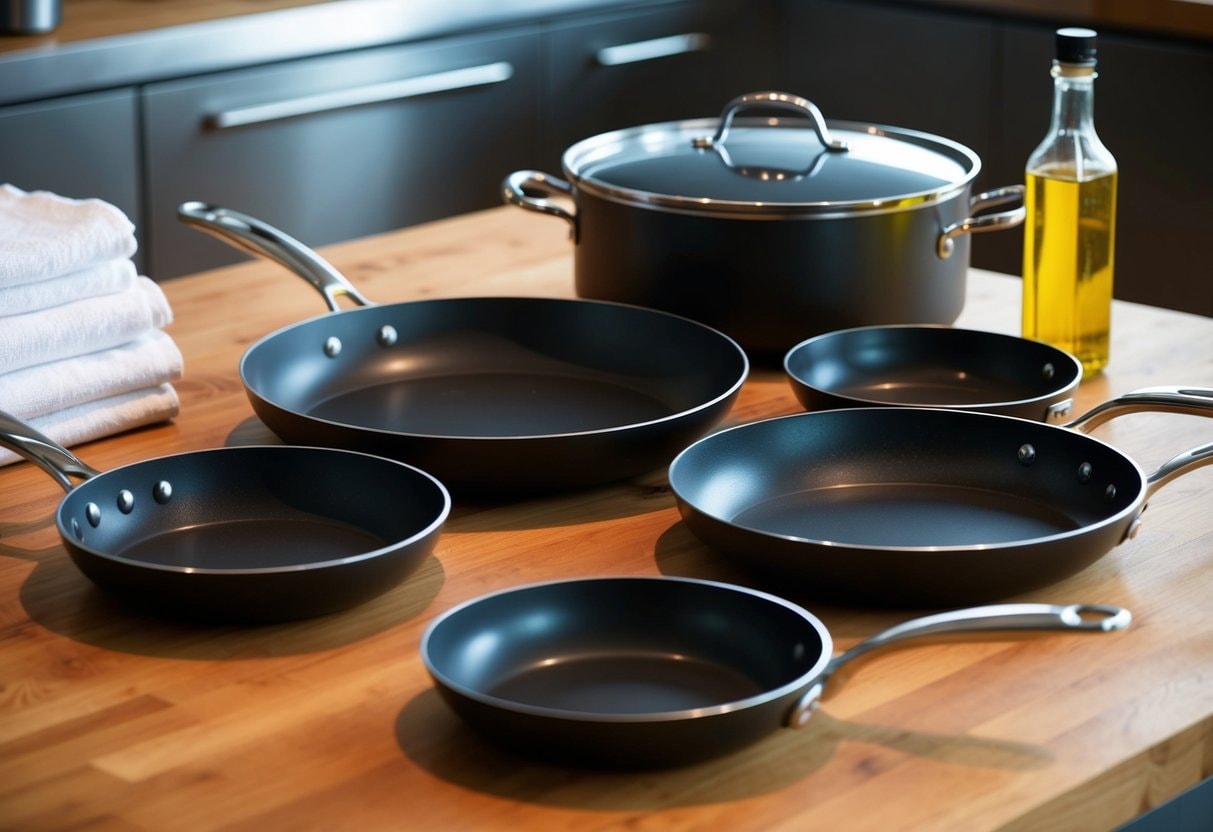
Carbon steel pans are a chef’s best friend in the kitchen. I love how they combine the best qualities of cast iron and stainless steel. These pans heat up fast, hold heat well, and develop a natural non-stick surface over time. Taking care of carbon steel pans is easy once you know the basics. Avoid using soap when cleaning carbon steel pans, as it can strip away the seasoning. Instead, I prefer wiping them with a paper towel or using hot water and a soft brush for tougher messes.
After cleaning, I dry my pan thoroughly and apply a thin layer of oil to keep it in top shape. Cooking with carbon steel pans is a joy. They’re great for searing meats, sautéing vegetables, and even baking. The more I use my pan, the better it gets. With proper care, my carbon steel pan has become one of my most versatile and reliable kitchen tools.
Key Takeaways
- Clean carbon steel pans without soap to maintain their seasoning.
- Apply a thin layer of oil after each use for protection.
- Regular use improves the pan’s non-stick properties over time.
Understanding Carbon Steel
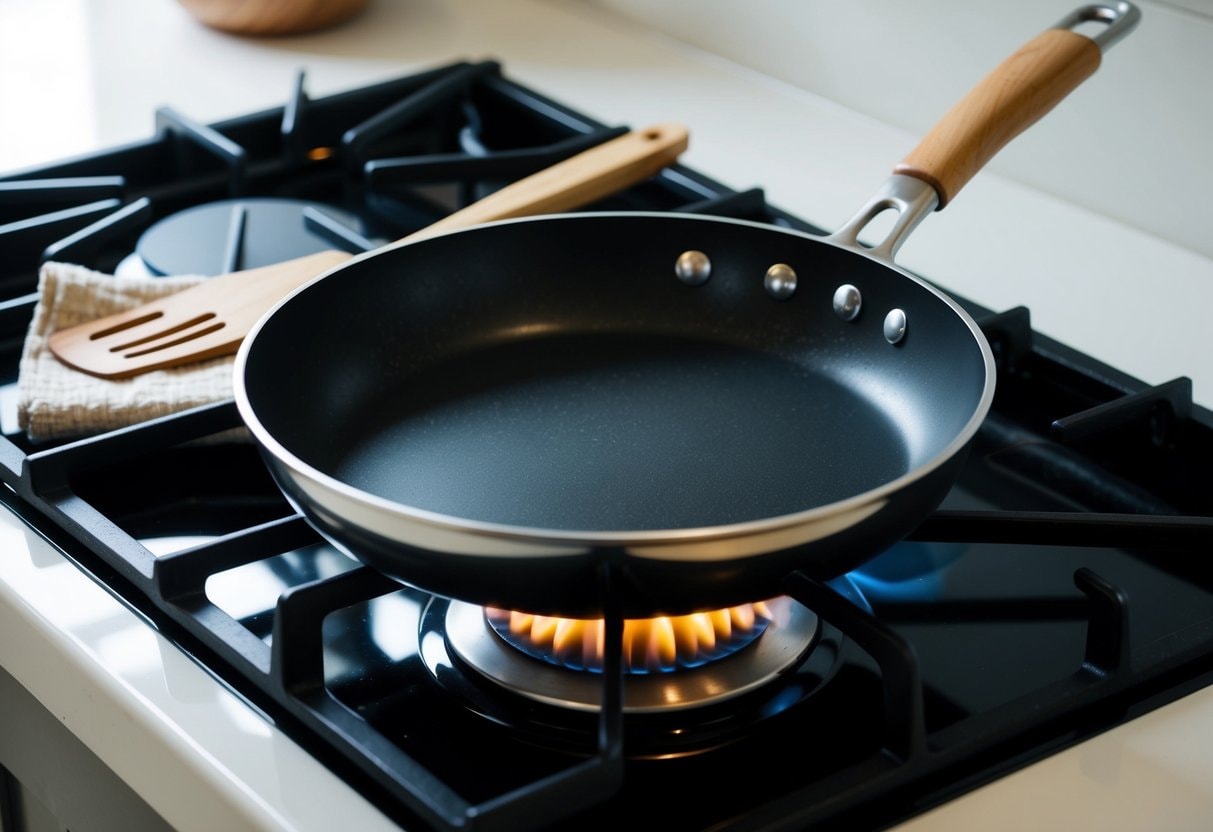
Carbon steel is a versatile material that’s great for cooking. I’ve found it combines the best qualities of cast iron and stainless steel. Let’s explore what makes carbon steel special and why it’s a top choice for many cooks.
What Is Carbon Steel?
Carbon steel is made of iron and about 1% carbon. It’s lighter than cast iron but heavier than stainless steel. I love how it heats up quickly and evenly. Carbon steel pans have a smooth surface that becomes non-stick when properly seasoned. They’re tough and can handle high heat, making them perfect for searing meats. These pans do need some care to prevent rust. But with a little effort, they’ll last for years. I’ve had mine for over a decade!
Carbon steel cookware has many benefits:
- Excellent heat conductivity.
- Develops a natural non-stick surface.
- Durable and long-lasting.
- Versatile for stovetop and oven use.
- Relatively lightweight.
Carbon steel is great for making crispy fried eggs and perfectly seared steaks. It’s also oven-safe, so I can start dishes on the stove and finish them in the oven. One of my favorite things about carbon steel is how it improves with use. The more I cook with it, the more non-stick it becomes.
Comparing Carbon Steel to Other Materials
Here’s how carbon steel stacks up against other common cookware materials:
| Material | Weight | Heat Conduction | Durability | Maintenance |
|---|---|---|---|---|
| Carbon Steel | Medium | Excellent | High | Moderate |
| Cast Iron | Heavy | Good | Very High | Moderate |
| Stainless Steel | Light | Fair | High | Low |
| Non-stick | Light | Poor | Low | Low |
I prefer carbon steel over non-stick for its durability and lack of chemicals. It beats stainless steel in heat conduction and develops a non-stick surface. Compared to cast iron, carbon steel is lighter and heats up faster. But both need similar care to maintain their seasoning.
Check out this video about Behind the Material: Carbon Steel from Made In Cookware.
By: Made In®
Initial Seasoning Process
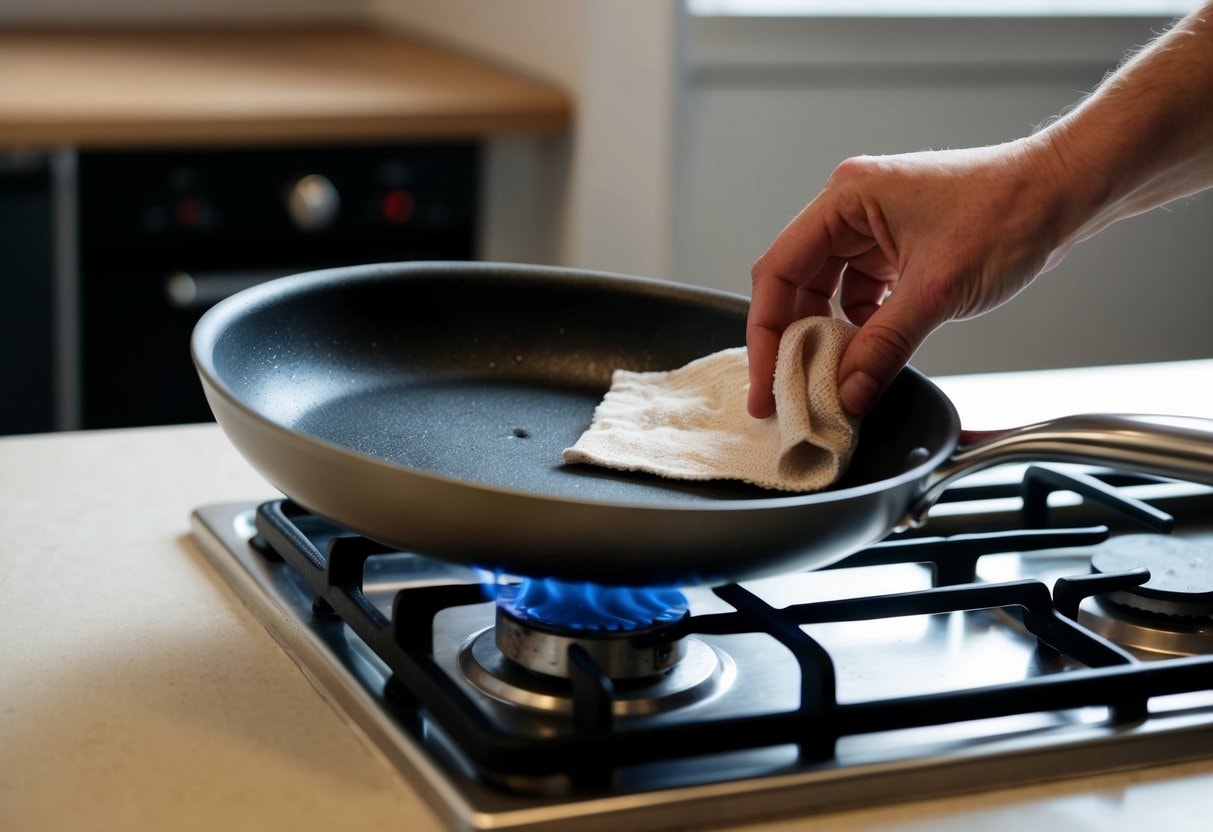
Seasoning new carbon steel pans is crucial for creating a non-stick surface and protecting it from rust. I’ll walk you through the process to ensure your pan is ready for cooking.
Preparing Your New Carbon Steel Pan
Before seasoning, I always make sure to clean my new pan thoroughly. I use hot water, dish soap, and a scrub brush to remove factory coatings or residues. Then, I dry the pan completely by wiping it with a towel and heating it on the stove for a few minutes. Some pans come with a protective wax coating. If yours does, I recommend using oil, salt, and potato peels to scrub off the wax. This method helps ensure a clean surface for seasoning.
Step-by-Step Seasoning Guide
- Heat the pan on medium until it’s hot.
- Add a small amount of high smoke point oil (like grapeseed or avocado).
- A paper towel spreads the oil evenly, coating the entire surface.
- Continue heating until the pan stops smoking and changes color.
- Repeat steps 2-4 a few times for a better seasoning layer.
I prefer to season on the stovetop, but you can also use an oven. If using the oven, I set it to 400°F and bake the oiled pan for about an hour. The pan will be very hot, so always use oven mitts!
Daily Care and Maintenance
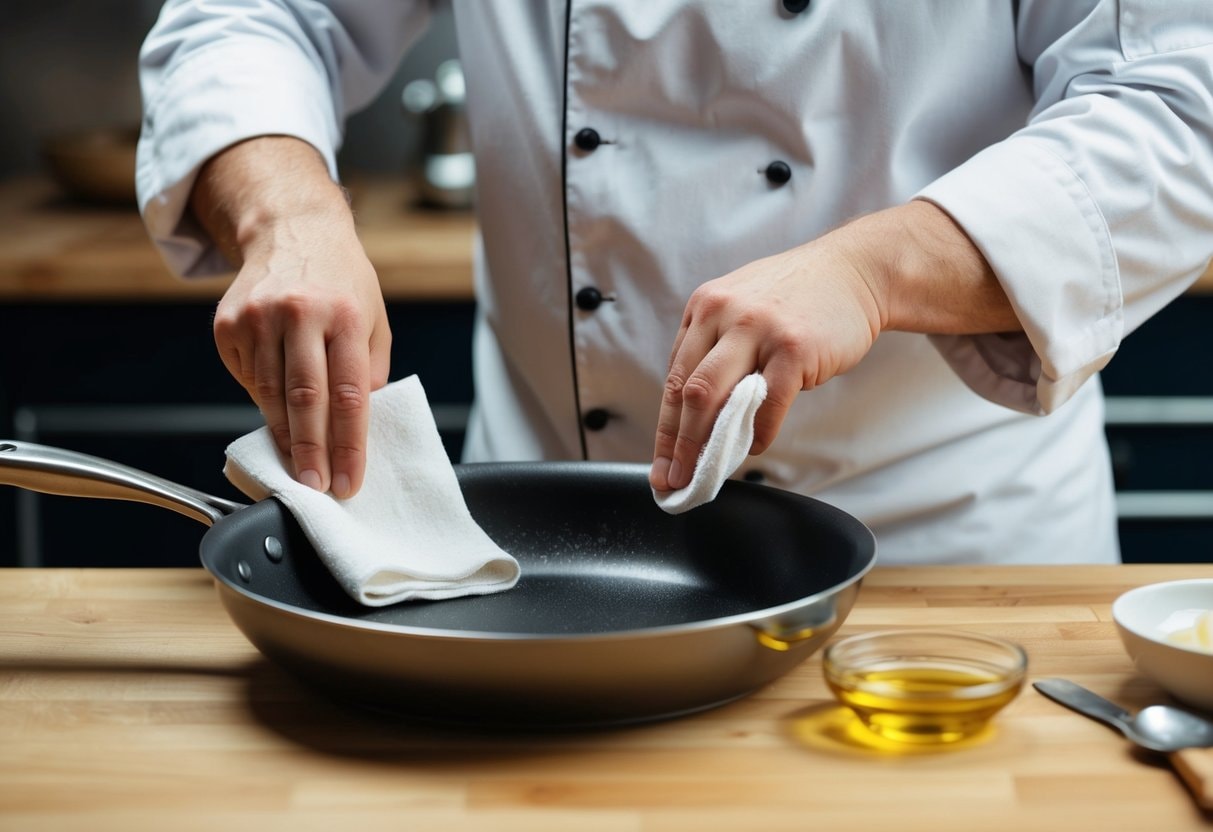
Taking care of your carbon steel pans is easy and quick. I’ll show you how to keep it in shape with simple daily habits.
Cleaning After Each Use
After cooking, I let my pan cool for a few minutes. Then, I rinse it with hot water and use a soft brush or sponge to remove food bits. No soap is needed! For stuck-on food, I add some hot water to the pan and bring it to a boil. This loosens stubborn residue. I scrape gently with a wooden spatula.
I dry my pan right away with a clean cloth or paper towel. Then, I put it on low heat for a minute to ensure it’s completely dry. Lastly, I rub a thin layer of oil on the surface. This keeps the seasoning in good condition.
Avoiding Rust: Dos and Don’ts
I never soak my carbon steel pan or leave it wet. Water is the enemy of steel and can cause rust. I always dry my pan thoroughly after washing. A quick heat on the stove helps evaporate any leftover moisture.
I store my pan in a dry place. If I stack pans, I put a paper towel between them to prevent scratches and absorb moisture. I don’t cook acidic foods like tomatoes or wine for long periods. These can strip the seasoning.
Tools for Cleaning: What to Use and Avoid
For cleaning, I use these soft tools:
- Soft brushes.
- Non-abrasive sponges.
- Wooden or silicone scrapers.
I avoid using these harsh tools:
- Steel wool.
- Metal scrubbers.
- Abrasive scouring pads.
I never use dish soap on my carbon steel. It can remove the seasoning I’ve worked hard to build up. For tough messes, I use coarse salt as a gentle abrasive. I sprinkle it in the pan, scrub it with a cloth, and rinse. I keep a chain mail scrubber on hand for really stubborn bits. It’s effective but gentle on the seasoning.
Did You Know?
Carbon steel pans are great for high-heat cooking methods. I love using them for searing meats and stir-frying veggies.
Addressing Common Cooking Concerns
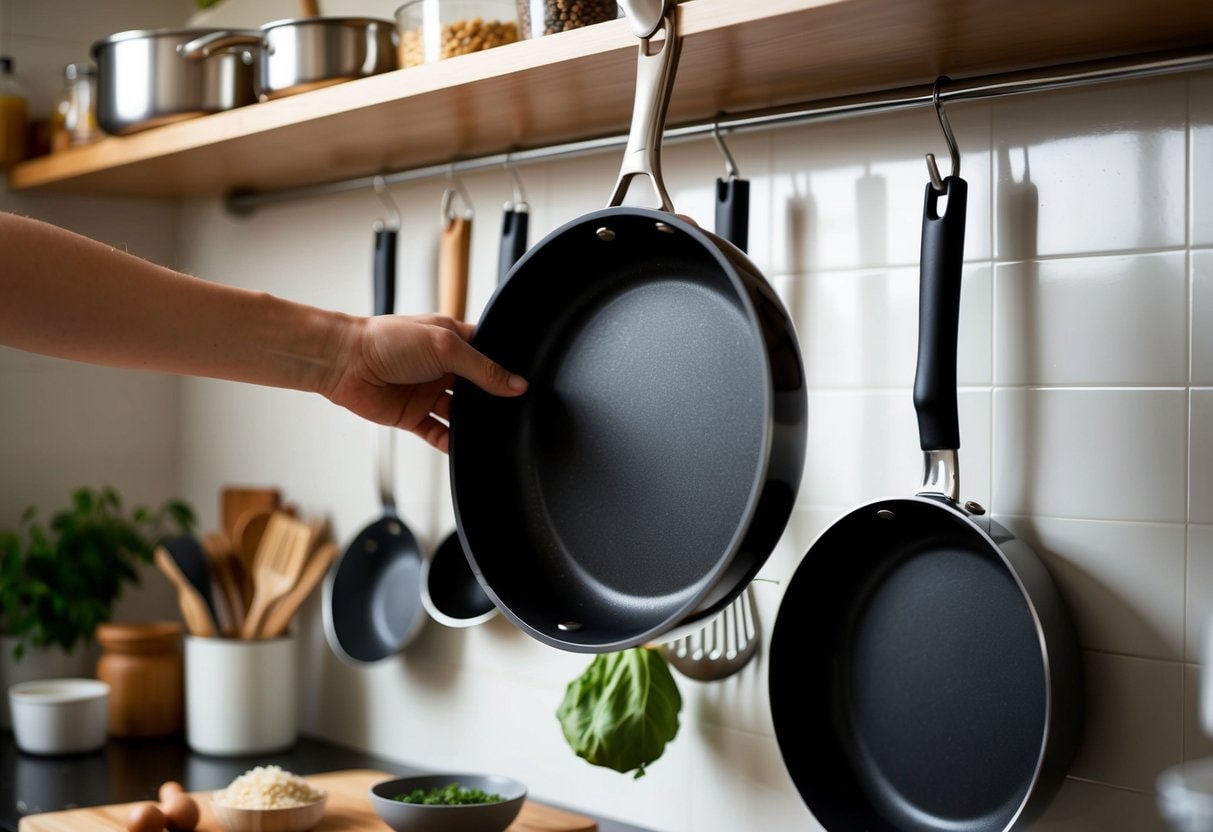
I know cooking with carbon steel pans can bring up some worries. Let me help you tackle two big ones – working with acidic foods and cleaning up stuck-on bits. I’ll share my best tips to make your carbon steel pan a joy to use.
Cooking Acidic Ingredients
Acidic ingredients can be tricky in carbon steel pans. Things like tomatoes, wine, and citrus can strip the seasoning if left too long. But don’t worry! I have a few tricks up my sleeve. For quick sauces, I keep the cooking time under 5 minutes. This way, my pan stays happy.
If I need to simmer longer, I use a different pan for those acidic dishes. After cooking acidic foods, I always give my pan a quick seasoning. I wipe it with oil and heat it. This keeps the surface in top shape.
Dealing with Food Residue
Stuck-on food bits? No problem! I’ve got easy ways to clean without harming my pan’s seasoning. For light residue, I use hot water and a soft brush. I sprinkle some salt in the pan and scrub with a paper towel for tougher bits. The salt acts like a gentle scouring pad.
If that doesn’t do the trick, I boil water in the pan for a few minutes. This loosens even the most stubborn bits. I never use soap – it can damage the seasoning I’ve worked so hard to build up. After cleaning, I always dry my pan on low heat and give it a thin coat of oil. This keeps it ready for my next cooking adventure!
Re-Seasoning Your Pan
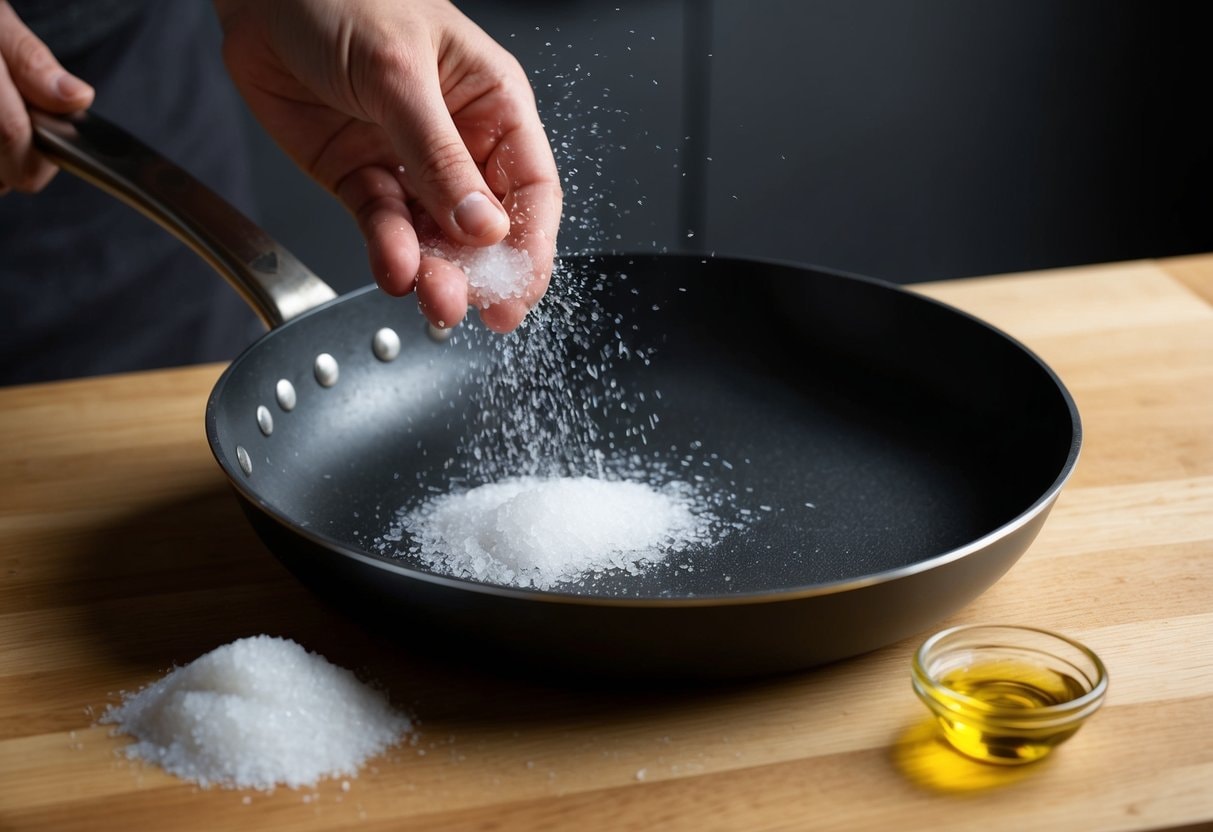
Re-seasoning is key to keeping your carbon steel pans in top shape. I’ll show you how to spot when it’s time for a touch-up and walk you through the easy process.
Signals That Your Pan Needs Re-Seasoning
I always keep an eye out for these signs:
- Food starts sticking more than usual.
- The pan’s surface looks patchy or dull.
- Rust spots appear.
If I see any of these, it’s time to act. I also re-season if I’ve cooked acidic foods like tomatoes or wine sauces. These can strip the seasoning. Sometimes, I notice a metallic taste in my food. This is a clear signal that my pan needs attention. I can’t wait to see this happening.
The Re-Seasoning Process
Here’s my simple method for re-seasoning:
- I clean the pan with hot water and a brush.
- I dry it completely on low heat.
- I apply a thin layer of high smoke point oil.
- I wipe off excess oil until the pan looks almost dry.
- I heat the pan until it stops smoking.
Did You Know?
Carbon steel pans are great for cooking special dishes. They work well for many types of cuisine and can handle high heat. Let’s look at how to use them for a classic Spanish dish.
Tips for Longevity
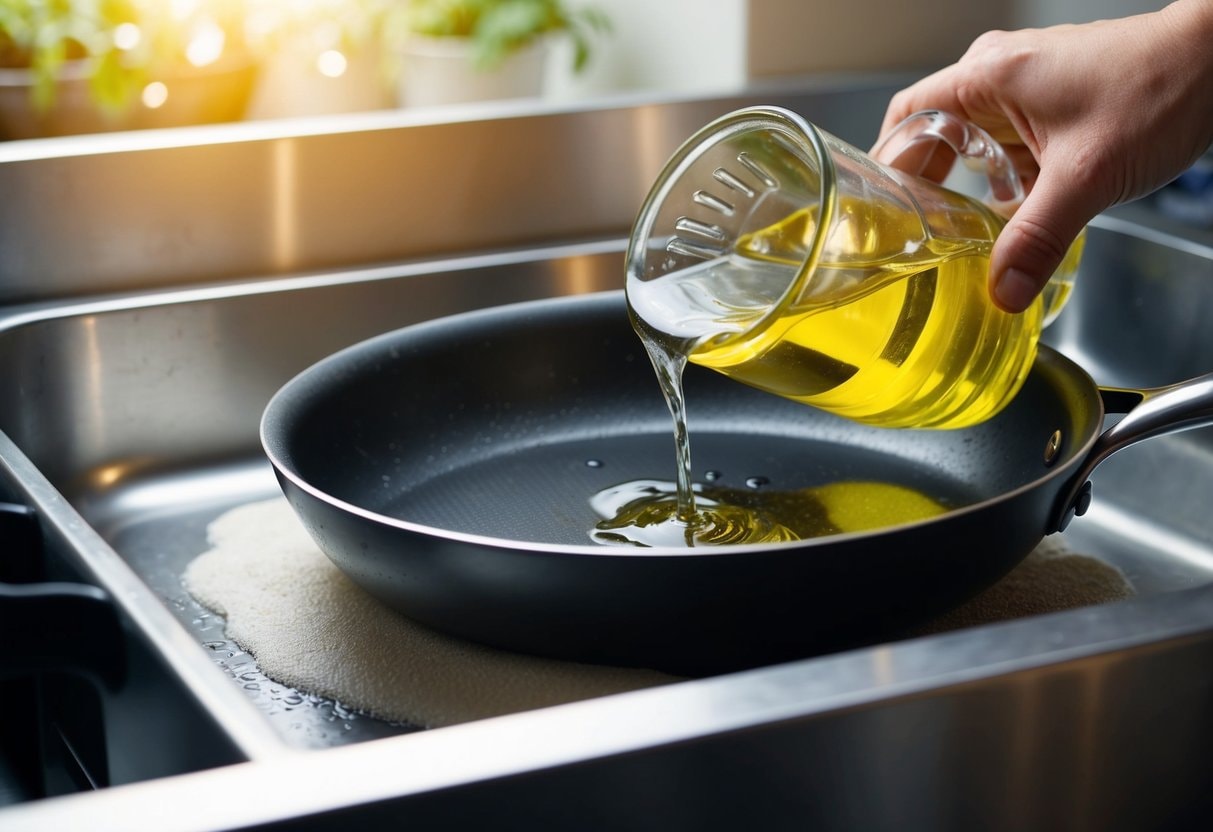
Taking good care of your steel pans helps them last for years. I’ll share my favorite ways to store these pans properly and when to use more fat for cooking. These simple tips can significantly affect how long your pans stay in great shape.
Storing Your Steel Pans
I always ensure my carbon steel pans are completely dry before storing them. Moisture can lead to rust. I also like to rub a thin layer of oil on the cooking surface. This extra step prevents rust and keeps the seasoning intact.
For stacking, I put a paper towel or cloth between pans. This protects the cooking surfaces from scratches. If you have the space, hanging pans is a great option. I use sturdy hooks to hang mine. I sometimes add a silica gel packet near the pans in humid areas. This absorbs excess moisture in the air. Remember to replace these packets regularly for the best results.
When to Use High Fat for Cooking
I’ve found that using high fat when cooking with steel pans has many benefits. It helps maintain the seasoning and prevents food from sticking. I use extra fat when cooking eggs, fish, or other delicate foods. I add more oil than I would with other pans for meats. This creates a nice crust and helps with flavor.
When stir-frying, I make sure there’s enough oil to coat the ingredients well. After cooking, I wipe the pan with a paper towel while it’s still warm. This spreads any leftover oil evenly, adding to the seasoning. If the pan looks dry, I add more oil before storing.
Check out this video on the Carbon Steel Pan Guide: Seasoning, Cleaning, Maintenance, and Cooking Techniques.
By: Chow House
A Recipe for Longevity: Ensuring Your Carbon Steel Pan Stays in Top Shape
In conclusion, carbon steel pans are an invaluable addition to any kitchen, offering a perfect blend of heat retention, durability, and versatility. With the right care and maintenance, these pans can last for years, continually improving with each use. Home cooks can ensure their carbon steel pans remain in peak condition by following the essential tips outlined in this article—such as avoiding soap when cleaning, re-seasoning as needed, and storing them properly.
Embracing these best practices enhances the cooking experience and allows for the development of that coveted natural, non-stick surface. As you continue experimenting and creating delicious meals, remember that the effort put into caring for your carbon steel pans will pay off with exceptional performance and flavor. With proper care, your carbon steel pan will become a trusted partner in your culinary journey, transforming how you cook and enjoy food.
Frequently Asked Questions
How Do You Properly Season a Carbon Steel Pan?
To season a carbon steel pan, I start by coating it with a thin layer of oil. Then, I heat the pan in the oven at a high temperature, usually around 450°F. This process creates a non-stick surface and protects the pan from rust. I repeat this seasoning process several times to build a strong layer. It’s important to use oil with a high smoking point, like grapeseed or canola oil.
What is the Best Method for Cleaning a Carbon Steel Pan After Use?
After cooking, I let the pan cool slightly and rinse it with hot water. I use a soft brush or sponge to remove any food residue. If there’s stubborn food stuck on, I might use some coarse salt as a gentle abrasive. I never use soap on my carbon steel pan, as it can strip the seasoning. After cleaning, I dry the pan thoroughly and apply a thin layer of oil before storing.
Can You Use Vinegar to Clean a Carbon Steel Pan, and if So, How?
I don’t recommend using vinegar to clean carbon steel pans regularly. Vinegar is acidic and can remove the seasoning. In rare cases, a brief vinegar soak might help for very stubborn rust. If I must use vinegar, I dilute it with water and only leave it on the pan for a few minutes. Afterward, I rinse thoroughly, dry completely, and re-season the pan.
Join and Find Us on Social Media
🔹 Facebook: Join our community on our Facebook page, VeganGlobetrotter, where we share inspiring plant-based recipes and tips for your vegan lifestyle.
🔹 Pinterest: Explore our Pinterest account, theveganglobetrotter, for a wealth of plant-based goodness and wellness resources.
🔹 Instagram: Follow us at _veganglobetrotter on Instagram for a visual feast of delicious vegan dishes.
🔹 Twitter: Stay informed about the latest vegan trends and insightful articles by following us on Twitter at VeganGlobetrot.



Don't miss out
when new recipes and information are added!
Join our newsletter for free recipes,
healthy living inspiration, and special offers
You have Successfully Subscribed!